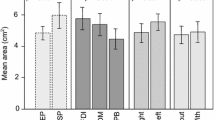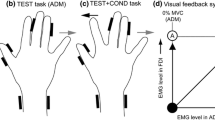Abstract
We performed transcranial magnetic stimulation of the motor cortex in 22 left-handed and 25 right-handed subjects during active contraction of a small hand muscle. Motor evoked potentials had the same latency, amplitude and threshold on both sides of the body, whilst the silent period duration was shorter in the dominant hand. Silent periods elicited by nerve and brainstem stimulation were the same in both hands. Since the latter part of the cortical silent period is due mainly to withdrawal of corticospinal input to spinal motoneurones, we speculate that the results are compatible with the suggestion that tonic contractions of the non-dominant hand are associated with a greater involvement of the corticospinal tract than those of the dominant hand. It also seems likely that there is an asymmetry in the excitability of cortical inhibitory mechanisms with those responsible for the cortical silent period being less excitable in the dominant motor cortex.
Similar content being viewed by others
Author information
Authors and Affiliations
Additional information
Received: 29 July 1998 / Accepted: 21 April 1999
Rights and permissions
About this article
Cite this article
Priori, A., Oliviero, A., Donati, E. et al. Human handedness and asymmetry of the motor cortical silent period. Exp Brain Res 128, 390–396 (1999). https://doi.org/10.1007/s002210050859
Issue Date:
DOI: https://doi.org/10.1007/s002210050859




